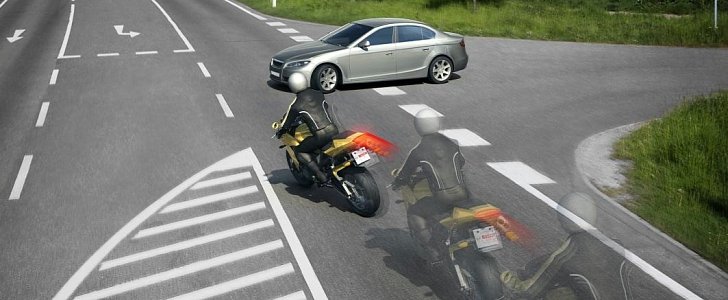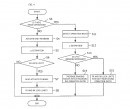It’s no longer a novelty in the car segment, but the automatic braking system will soon jump the fence in the motorcycling yard as this new patent application published by the U.S. Patent and Trademark Office reveals Honda is working on such a thing.
Several 2017 Honda automobiles are already fitted with the Collision Mitigation Braking System, and the company is looking forward to implementing this safety system on motorcycles too.
How can you tell? Just look at this operating scheme found with the recently published patents. It’s mentioning front and rear independent brake operation controlled by an automated system along with wheel locking limits. Yep, motorcycle related items.
As with the ones fitted on cars, the system works by calculating a possibility of a collision with a vehicle or object up ahead, most probably using a front facing radar.
If a possible collision is detected, the system verifies if the rider has already acknowledged this by starting to brake. If that happened, the system will only provide extra braking pressure while maintaining the same ratio of front and rear braking.
In case the rider has not started braking, the system would first pump the rear brake to prevent the motorcycle nose-diving. The algorithm then calculates the friction coefficient of the road surface before determining the braking limits.
If the brake reaches the limit, the system starts applying the front brake, continuing until the motorcycle stops or the obstacle is no longer in its direct path. Yay science!
The system makes sense now, as Honda recently revealed a self-balancing concept motorcycle that isn’t relying on the bulky gyroscope effect to keep it the right side up.
Instead, it uses two actuators that modify the fork angle and steering along with a computer that makes these fine and rapid adjustments to keep it straight even when not going forward.
I belive that these two systems should be interconnected as not every rider might be comfortable with a motorcycle that suddenly decides to stop. Even though it can avoid a collision, the rider might be taken by surprise and topple over with the machine and if this happens on a cliff, guess who gets sued?
How can you tell? Just look at this operating scheme found with the recently published patents. It’s mentioning front and rear independent brake operation controlled by an automated system along with wheel locking limits. Yep, motorcycle related items.
As with the ones fitted on cars, the system works by calculating a possibility of a collision with a vehicle or object up ahead, most probably using a front facing radar.
If a possible collision is detected, the system verifies if the rider has already acknowledged this by starting to brake. If that happened, the system will only provide extra braking pressure while maintaining the same ratio of front and rear braking.
In case the rider has not started braking, the system would first pump the rear brake to prevent the motorcycle nose-diving. The algorithm then calculates the friction coefficient of the road surface before determining the braking limits.
If the brake reaches the limit, the system starts applying the front brake, continuing until the motorcycle stops or the obstacle is no longer in its direct path. Yay science!
The system makes sense now, as Honda recently revealed a self-balancing concept motorcycle that isn’t relying on the bulky gyroscope effect to keep it the right side up.
Instead, it uses two actuators that modify the fork angle and steering along with a computer that makes these fine and rapid adjustments to keep it straight even when not going forward.
I belive that these two systems should be interconnected as not every rider might be comfortable with a motorcycle that suddenly decides to stop. Even though it can avoid a collision, the rider might be taken by surprise and topple over with the machine and if this happens on a cliff, guess who gets sued?



